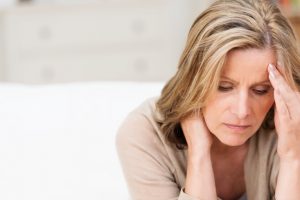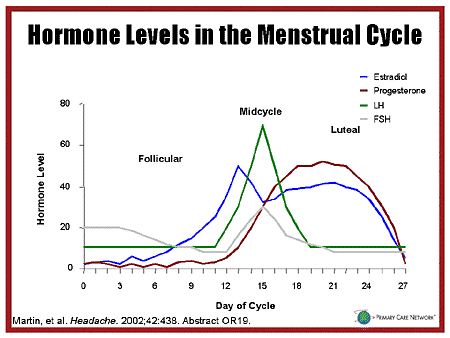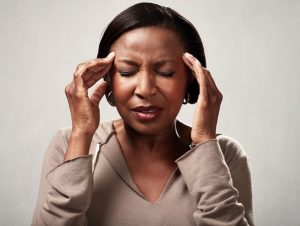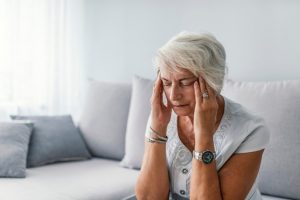Overview
There is a strong link between migraines and the female sexual hormones – oestrogen and progesterone.
Both perimenopause and menopause result from a change in hormone production by the ovaries. In perimenopause, hormone headaches are usually due to a fluctuation in oestrogen levels combined with a reduction in progesterone production. We call this an “oestrogen build up headache”. It gets worse the closer a woman gets to the end of her cycle. In menopause, the headaches often relate to a drop in the oestrogen level and can occur at any time.
What Are Hormonal Headaches?

In perimenopause, hormone headaches are usually due to a fluctuation in oestrogen levels combined with a reduction in progesterone production.
Many factors contribute to headaches for both men and women, including family history and age. Women, however, often notice a relationship between headaches and hormonal changes. The hormones oestrogen and progesterone play key roles in regulating the menstrual cycle and may also affect headache-related chemicals in the brain.
Having steady oestrogen and progesterone levels may improve headaches, while experiencing oestrogen and progesterone levels that dip or change can make headaches worse. Though fluctuating hormone levels can influence headache patterns, you’re not completely at the mercy of your hormones. These hormone-related headaches can be controlled and treated.
Oestrogen Build Up Headaches:
A simple description of a menstrual cycle is as follows:
- The menstrual cycle of most women lasts 28 days, however this may vary in some women.
- The first day of menstruation (bleeding) is regarded as day one of your cycle. On day one, both oestrogen and progesterone levels are low and both levels remain relatively low for most of the first half of your cycle.
- However, around day 12 of the cycle, the oestrogen does have a mid-cycle surge just prior to ovulation and then drops off again.
- After ovulation, the oestrogen starts its climb towards the end of the cycle. A day or so before the next bleed, the oestrogen level drops off again.
- The progesterone is expected to keep pace with the increase of oestrogen and is thought to “balance out the oestrogen” and helps to offset the possible side effects of too much oestrogen.
- If there is insufficient progesterone being produced or your oestrogen receptors are overly sensitive to oestrogen, this gradual build-up of oestrogen may cause headaches.

- Other symptoms that may accompany this oestrogen build-up include:
- Irritability
- Moodiness
- Fluid retention
- Weight gain
- Skin changes like acne
Oestrogen Drop Off Headaches:
- In relation to the menstrual cycle described above, an oestrogen drop off headache usually occurs just before the bleed starts or just as the bleed starts. A headache may also occur around ovulation time due to the oestrogen surge and consequent drop off. (1)
- Symptoms that may accompany an oestrogen drop-off headache include:
- Feeling emotional
- Anxiety
- Hot flushes and/or sweats
How Long Will I Be Having Hormonal Headaches For?

A headache may also occur around ovulation time due to the oestrogen surge and consequent drop off.
The majority of women who suffer with migraines in their reproductive years have them premenstrually i.e. leading up to their period. These can occur from a very young age – in her teenage years, and may continue until her hormone levels drop, when she goes into menopause.
Because hormonal headaches depend on the changes of oestrogen and progesterone, as you get older, the hormone headaches become less frequent and will likely disappear altogether. Unfortunately, in some women, they can continue for many decades.
The Typical Hormonal Headache Experience
Hormonal headaches or migraines are similar to a regular migraine and may or may not be preceded by an aura. The migraine is a throbbing pain that starts on one side of the head. It may also involve sensitivity to light and nausea or vomiting.
Other symptoms of hormonal headaches include:
- loss of appetite
- fatigue
- joint pain
- lack of coordination
- cravings for alcohol, salt, or chocolate
Are you experiencing this symptom?
Take the questionnaire to determine if it may be a sign of menopause, and discover how we can help

Each person is different and therefore different foods may trigger a headache. Keeping a food diary may assist in pinpointing your food trigger.
What Causes And Triggers Hormonal Headaches?
Many women with migraines report headaches before or during menstruation. Also, because of the changes in oestrogen and progesterone around ovulation, some women report headaches around the middle of the cycle too.
The build-up of oestrogen leading up to your period and/or the significant drop in oestrogen just before your period are the main causes of hormonal headaches. Also, insufficient production of progesterone after ovulation (mid-cycle) and leading up to your period may be contributing to your headache problem.
What Can I Do To Prevent Hormonal Headaches?
Over the time you have suffered with these menstrual headaches, you would probably have tried some of these treatments:
- Applied ice to the painful area
- Relaxation exercises
- Acupuncture
- Taken over-the-counter pain relievers like nonsteroidal anti-inflammatory drugs (NSAIDs), such as ibuprofen
A good diet and healthy lifestyle can help with reducing the number of headaches, their severity or alleviate them altogether
Lifestyle changes include:
Diet
Each person is different and therefore different foods may trigger a headache. Keeping a food diary may assist in pinpointing your food trigger. Each time you have a headache try and write down what you ate leading up to the headache. Over time you may find a pattern of a common food or food group in your diet that may be causing the headaches. Once you have developed a pattern try and remove this from your diet.
Some common food triggers are:
- Alcohol
- Cheese
- Caffeine
- Chocolate
- Dairy
Exercise
Light to moderate exercise may help prevent headaches. A light walk outdoors, or swimming are good exercise options. Try to do this regularly, at least three times a week for 30 minutes.
Treatment of Hormonal Headaches
- antidepressants and/or beta-blockers
Betablockers are traditionally used for treating angina and high blood pressure but its also shown to effectively prevent migraines. It works by slowing the effect of adrenalin and thus slows your heart.
- other prescription medications such as dihydroergotamine.
Dihydroergotamine works by constricting the intracranial blood vessels. It also stimulates serotonin receptors. It can be very effective in severe migraines.
Alternative and Herbal Therapies:
- Acupuncture – studies have shown that acupuncture can be effective in treating the chronic pain of headaches
- Massage with essential oils
- Exercise
- Healthy eating
Supplements:
- Magnesium has shown to reduce stress and reduce migraine frequency
- Riboflavin or Vitamin B2 found in dairy products, grains and certain plants is thought to help with migraine prevention
- CoQ10 in a dosage of 100mg three times a day reduced the frequency of headaches
Hormone Replacement Therapy
Bio-identical Hormone Replacement Therapy (BHRT)
Bio-Identical hormones also known as body identical hormones have the exact molecular structure as those made in the human body. Bio-identical hormones can be extracted from a number of natural sources such as Wild Yam.
In a normal cycle, there are two phases – the follicular phase that runs from the first day of the bleed to the middle of the cycle (ovulation) and the luteal phase that runs from ovulation up till the end of the cycle. By introducing the correct hormone and dosage at the right time, a more accurate balance can be achieved with a better outcome.
If you are experiencing hormonal headaches, please do not hesitate to contact us on 1300 883 405 to book a free consultation and discuss this with one of our doctors.
(1) https://www.ncbi.nlm.nih.gov/pmc/articles/PMC4102139/
Book A Free Medical Consultation
Speak with one of our doctors confidentially to discuss & if you are suitable a treatment plan will be prescribed.